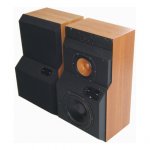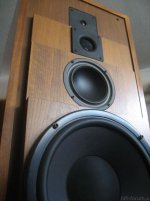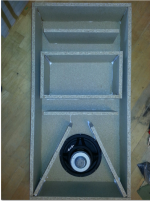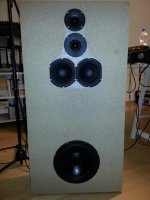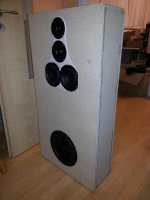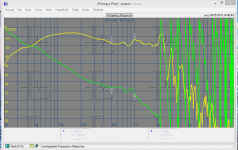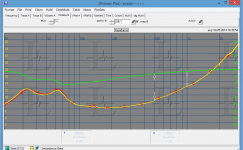hi joachim, Im trying to understand the logic of using two tweeters.
The tw022wa06 seems to be able to do the 1khz to 20khz.
I can see that the TW030WA05 is able to go down a bit more...
If I look at the curve of the TW030WA05, I guess you have to cross around 4khz?
so the xo point will be like: 100hz/1khz/4khz?
Anyways, exciting project. For anyone, the mid is out of stock at madisound but will be available in may.
Will the cabinet be sealed?
I will build this speaker! yeah! thanks joachim!
The tw022wa06 seems to be able to do the 1khz to 20khz.
I can see that the TW030WA05 is able to go down a bit more...
If I look at the curve of the TW030WA05, I guess you have to cross around 4khz?
so the xo point will be like: 100hz/1khz/4khz?
Anyways, exciting project. For anyone, the mid is out of stock at madisound but will be available in may.
Will the cabinet be sealed?
I will build this speaker! yeah! thanks joachim!
Last edited:
Member
Joined 2009
It's shaping up to be a great design.
The combination of a lower tweeter and dual midrange should give very low distortion and dynamic capacity. It's the kind of speaker that I see and I'm immediately curious to audition.
Arranging the mids side-by-side could create an inconsistency in the horizontal directivity pattern. I don't expect it to have a significant impact on the sound but that's up to you to decide. The "monkey coffin" speaker boxes tend to have edge reflection issues. I suppose you have already considered large rounds on the corners and felt around the tweeters.
The combination of a lower tweeter and dual midrange should give very low distortion and dynamic capacity. It's the kind of speaker that I see and I'm immediately curious to audition.
Arranging the mids side-by-side could create an inconsistency in the horizontal directivity pattern. I don't expect it to have a significant impact on the sound but that's up to you to decide. The "monkey coffin" speaker boxes tend to have edge reflection issues. I suppose you have already considered large rounds on the corners and felt around the tweeters.
Arranging the mids side-by-side could create an inconsistency in the horizontal directivity pattern.
I did some quick modeling in the Edge..
-at a meter's distance the horizontal change is relatively small within about +/- 45 degrees up to a little less than 3 kHz.
-even at a half-meter it's still showing little deviation to about 1.8 kHz.
At 1 kHz or less (crossover freq.), it shouldn't be a problem with an appropriate crossover filter.
Because you listen to the entire "field", the gradient as pressure drops with distance will likely sound a bit different than a vertical orientation of the drivers. (..and that's been my subjective experience.)
Last edited:
To cross the woofer at 100Hz is too low i think. First very big coils will be needed and second i will try to avoid the Allison Effect. That is a hole in the frequency response at ca. 300Hz. It happens because there is a double path to the ear ( microphone ).
One is direct from the driver and one is refected from the floor.
So it will aprox. be 300Hz, 1kHz, 5kHz.
There are two reasons for a double tweeter arrangement :
First the bigger Wavecore is beaming at higher frequencies.
Second the bigger wavecor is working in the most sensitive region of the ear so we have very little moving mass there.
0.4g instead of say 15g in a conventional midrange.
I also expect less doppler and intermodulation distortion from a 4 way.
One is direct from the driver and one is refected from the floor.
So it will aprox. be 300Hz, 1kHz, 5kHz.
There are two reasons for a double tweeter arrangement :
First the bigger Wavecore is beaming at higher frequencies.
Second the bigger wavecor is working in the most sensitive region of the ear so we have very little moving mass there.
0.4g instead of say 15g in a conventional midrange.
I also expect less doppler and intermodulation distortion from a 4 way.
Maybe i phase aligne the drivers like this :Pin by Holger Barske on Audio Krempel I like | Pinterest
Attachments
The boxes are damped and one box got the drivers. I can make a crossover now.
Attachments
The tweeters are from Wavecor.
They have a waveguide that sets them back and the midranges have a raher shallow cone so i think i do not need a stepped baffle.
I also have an idea how to integrate the woofer.
They have a waveguide that sets them back and the midranges have a raher shallow cone so i think i do not need a stepped baffle.
I also have an idea how to integrate the woofer.
I measured the woofer. Instead of one main resonance there are actually two well damped peaks. That must be the cambers inside. The good thing is that under 50Hz there is still energy down to 32Hz although as a shelf. Also the phase angle of the impedance in the bass is very low so this woofer is easy to drive.
I did multi chamber systems like that in the 80th so i knew that something similar will happen.
I did multi chamber systems like that in the 80th so i knew that something similar will happen.
Attachments
The 500Hz is a measurement artifact.
I should calibrate new.
One box ( red ) shows more wrincles then the other. I do not know why.
I stuffed and build them the same.
I have stuffed maybe only 50%. With more stuffing i think the wricles go away.
I should calibrate new.
One box ( red ) shows more wrincles then the other. I do not know why.
I stuffed and build them the same.
I have stuffed maybe only 50%. With more stuffing i think the wricles go away.
I was more concerned with the wrinkles between 80-220hz range the xover will deal with the highers ones ...Did you do any measure of them in free space .
The driver without the cabinet ? No.
I think the box is stiff enough so more damping will reduce the wrincles i think.
When i measured the boxes there where not in the same space so i will remeasure in the same location.
I think the box is stiff enough so more damping will reduce the wrincles i think.
When i measured the boxes there where not in the same space so i will remeasure in the same location.
- Status
- Not open for further replies.
- Home
- Loudspeakers
- Multi-Way
- The Quintessentially German Loudspeaker of the 70th. Modern Interpretation.
